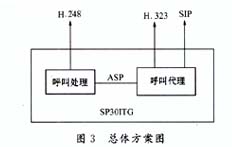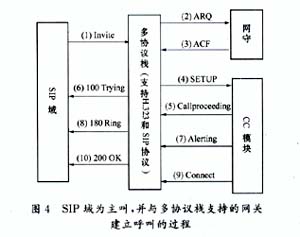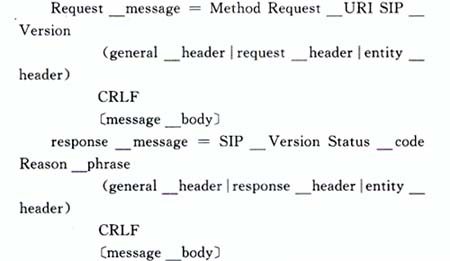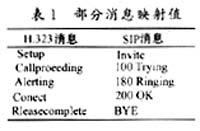Solutions for IP phone multi-protocol stack support
ã€Abstract】 Introduce IP telephony gateway, SIP protocol and H.248 protocol, and propose an IP telephony gateway solution supporting H.248 and SIP protocol based on H.323 protocol stack
Keywords: H.323 SIP Gateway Gatekeeper
1 Introduction According to the "Overall Technical Requirements for IP Telephone / Fax Services", from the perspective of conformity and interoperability of international standardization, the construction of China's IP telephone / fax network should be based on ITU-TH. The 323 protocol is the standard. Based on this, we have developed an IP telephone / fax gateway system that supports the H.323 protocol stack. However, with the continuous development of network and VoIP (Voice over Internet Protocol) technologies, gateway systems that adapt to different networks must be developed to support the different needs of operators.
H.248 and SIP (Session IniTIaTIon Protocol, Session Initialization) protocols are relatively popular and fast-developing network protocols recently. This article will propose these two and the current H.248. The 323 protocol stack effectively combines the developed solutions.
2 Introduction to the IP gateway developed The gateway SP30ITG of the carrier-grade VoIP system developed is based on standards and supports including ITU-TT. 120 and H. Various international standards including 323. In addition, the system uses G. 711, G. 723.1 and G. 729a voice coding technology to ensure compatibility with major telephone systems. The following introduces the software modules of the system (as shown in Figure 1).

The software system of the VoIP module is divided into two major modules, CA (CallAgent, call agent) module and MG (Media Gateway, media gateway) module. The CA part runs on the CA board and mainly completes call control, protocol processing, and resource management. The MG part runs on the MG board and mainly completes voice compression and decompression, RTP / RTCP (Real-TIme Transport Protocol / Real-TImeTransport Control Protocol, real-time transport protocol / real-time transport control protocol) processing, etc.
The software structure of the CA part is divided into three modules: CC (CallControl, call control), RM (Resource Manage, resource management), H. 323. H. 323 is responsible for the signaling processing on the IP network side, the device management is responsible for the management of the media gateway board, and the call control is responsible for the control of the IP call service logic. These services include the IP phone service of the card number user, the IP phone service of the calling user, and the card number user's IP fax services, IP fax services for calling users and other value-added services based on VoIP, such as Internet call waiting, unified messaging, voice mail and other services. H. The 323 protocol stack and call control module are the core of the system.
The MG board software system is divided into three parts, namely the microprocessor software part, the dual-tone detection / tone generation part and the Voice / Fax DSP part. The software part of the microprocessor completes the management of the entire MG board and communicates with the CA; DTMF / TONE completes the reception of DTMF (Dual-Tone Multi Frequency, dual-tone multi-frequency) tones, and prompts the generation of voice; Voice / Fax DSP partly completes Compression and decompression of the voice / fax PCM stream, while accomplishing functions such as mute compression, echo suppression, and jitter elimination.
3 Introduction to H.248 protocol and SIP protocol The main function of H.248 protocol is to establish a good service bearer connection model, separate the call and bearer connection, and manage the various media gateways to realize the packet network and PSTN Business interoperability. H. 248 provides a standard interface for the user plane and control plane, making it possible to separate the network and services.
H. The basic idea of ​​248 is to disassemble the gateway device in the IP phone, split it into two, the two parts after separation, one is called MGC (Media Gateway Controller, media gateway controller), it manages the high-level (more than three layers ) Resources, such as signaling and channel resources are allocated to the signaling exchange of the high-level management system; the other part is called MG (Media Gateway), which manages the underlying resources, such as voice streams (including encoders), collecting dialing numbers, providing various Dial tone, etc. The gateway is decomposed into MGC and MG, and its schematic diagram is shown in Figure 2.

At present, China has determined to use ITU-T's H. IP phone. 323 protocol system, but because of its complicated structure, it is more difficult to achieve, so the IETF working group proposed the session initialization protocol SIP. SIP is a client / server protocol, and protocol messages are divided into two categories. Among them, the request message is sent from the client to the server, and the response message is sent from the server to the client. Generally, SIP is implemented through the "invitation" method. So "invitation" is the core mechanism of SIP protocol.
With H. Compared with 323, the call control functions and services supported by SIP are basically the same. At the same time, because the SIP protocol is simple and uses text, it has better function expansion and network scalability, and is easy to implement. H. 323 has more complete call and resource management functions, stronger media negotiation functions and strict backward compatibility.
Internationally, SIP-based IP telephone systems are developing, and some manufacturers have provided commercial SIP systems, so there is an urgent need to support H. Multi-protocol stack of 323 and SIP.
4 H. 323, SIP and H. 248 Multi-protocol stack supported solutions The following introduces the overall solution of multi-protocol stack implementation, and focuses on the implementation of H.CA on CA. 323 and SIP support.
4.1 The overall scheme of multi-protocol stack Due to the flexibility of SIP messages, it is possible to implement SIP signaling calls for IP phones / fax without changing the original ASP signaling between the CC and the switch. And H. The 248 protocol specifies the message flow of a call, and the details related to the switch, such as ringing and ring back tone, cannot be realized without changing the ASP signaling, so consider placing it on the switch side More appropriate. But from the perspective of the overall SP30ITG gateway system, it reflects the support of three protocols (as shown in Figure 3).

4.2 Implementation of H.CA on CA The support of 323 and SIP is due to The 323 gateway initiates the call and the usual H. The call establishment process between 323 gateways is the same, so the following takes SIP domain to initiate a call and the called party is a multi-protocol stack gateway (SP30ITG) as an example to describe the specific implementation of multi-protocol stack (flow chart shown in Figure 4).

The call establishment process corresponding to FIG. 4 is roughly as follows:
(1) When the multi-protocol stack receives the INVITE message from the SIP domain, it converts the message format.
(2) Pass H. The 323 gatekeeper sends ARQ to verify the validity of the calling user.
(3) If the calling user is a legitimate user, the gatekeeper will send an ACF (admission confirmation, authentication confirmation) message to the multi-protocol stack.
(4) When the multi-protocol stack receives the ACF message, it will send a SETUP message to the CC module.
(5) The CC module sends a Callproceeding message to the multi-protocol stack, which contains the local channel message.
(6) After receiving the Callproceeding message sent by the CC, the multi-protocol stack converts it into a SIP 100 trying message response and sends it back to the SIP caller.
(7) The CC module sends Alerting messages to the multi-protocol stack.
(8) After receiving the Alerting message sent by the CC, the multi-protocol stack converts it into a SIP 180 Ringing message response and sends it back to the SIP caller.
(9) When H. 323 After the called party goes off-hook, the CC module will send a Connect message to the multi-protocol stack.
(10) After receiving the Connect message sent by the CC, the multi-protocol stack converts it into a SIP 200 OK message response and sends it back to the SIP caller.
5 Two key problems and solutions in call establishment
5.1 Message conversion due to H. The message format of the 323 system follows ASN. 1 standard, and SIP uses a message format similar to the HTTP protocol. In order to realize the call establishment between the two, you must perform message conversion.
ASN. The basic coding rule of 1 is a nested structure. Its basic structure is composed of 3 parts, which are an identifier 8bit group, a length 8bit group, and a content 8bit group. In some cases, there is a content end 8bit group.
The format of the SIP message is related to the type of message. The request message represents the message from the client to the server, and the response message is the message from the server to the client.

The following uses SIP INVITE message as an example to describe the method of message conversion between the two. In different call modes, the way in which SIP can be mapped is also different. For example, in the case of fast calling, the INVITE message of IP just maps to a SETUP message of H.323. In a slow call, the INVITE message can be converted into SETUP and H. 245 messages. Therefore, in the multi-protocol stack, different message mapping tables must be selected according to different call modes.
In the message conversion, the content conversion of the message should also be included. H. Part of the message content conversion of 323 and SIP is shown in Table 1.

5.2 Conversion of media stream format In SIP, description is done by SDP (Session Description Protocol) protocol, and H. In 323, H. 245 to achieve media control, therefore, the media negotiation process is SDP protocol and H. 245 protocol interaction process.
6 Concluding remarks have been completed in H. Based on the 323 protocol stack, a specific solution supported by multiple protocol stacks is proposed, which is completely feasible on the existing gateway system SP30ITG.
2 M. Handly. SIP: Session Initiation ProtocolIETF-RFC2543, 1999
3 ITU-T Rec. H225. 0 Media Stream Synchronization for Visual Telephone Systems on Non-Guaranted Quality of Service LANs. 1996
Keywords: H.323 SIP Gateway Gatekeeper
1 Introduction According to the "Overall Technical Requirements for IP Telephone / Fax Services", from the perspective of conformity and interoperability of international standardization, the construction of China's IP telephone / fax network should be based on ITU-TH. The 323 protocol is the standard. Based on this, we have developed an IP telephone / fax gateway system that supports the H.323 protocol stack. However, with the continuous development of network and VoIP (Voice over Internet Protocol) technologies, gateway systems that adapt to different networks must be developed to support the different needs of operators.
H.248 and SIP (Session IniTIaTIon Protocol, Session Initialization) protocols are relatively popular and fast-developing network protocols recently. This article will propose these two and the current H.248. The 323 protocol stack effectively combines the developed solutions.
2 Introduction to the IP gateway developed The gateway SP30ITG of the carrier-grade VoIP system developed is based on standards and supports including ITU-TT. 120 and H. Various international standards including 323. In addition, the system uses G. 711, G. 723.1 and G. 729a voice coding technology to ensure compatibility with major telephone systems. The following introduces the software modules of the system (as shown in Figure 1).

The software system of the VoIP module is divided into two major modules, CA (CallAgent, call agent) module and MG (Media Gateway, media gateway) module. The CA part runs on the CA board and mainly completes call control, protocol processing, and resource management. The MG part runs on the MG board and mainly completes voice compression and decompression, RTP / RTCP (Real-TIme Transport Protocol / Real-TImeTransport Control Protocol, real-time transport protocol / real-time transport control protocol) processing, etc.
The software structure of the CA part is divided into three modules: CC (CallControl, call control), RM (Resource Manage, resource management), H. 323. H. 323 is responsible for the signaling processing on the IP network side, the device management is responsible for the management of the media gateway board, and the call control is responsible for the control of the IP call service logic. These services include the IP phone service of the card number user, the IP phone service of the calling user, and the card number user's IP fax services, IP fax services for calling users and other value-added services based on VoIP, such as Internet call waiting, unified messaging, voice mail and other services. H. The 323 protocol stack and call control module are the core of the system.
The MG board software system is divided into three parts, namely the microprocessor software part, the dual-tone detection / tone generation part and the Voice / Fax DSP part. The software part of the microprocessor completes the management of the entire MG board and communicates with the CA; DTMF / TONE completes the reception of DTMF (Dual-Tone Multi Frequency, dual-tone multi-frequency) tones, and prompts the generation of voice; Voice / Fax DSP partly completes Compression and decompression of the voice / fax PCM stream, while accomplishing functions such as mute compression, echo suppression, and jitter elimination.
3 Introduction to H.248 protocol and SIP protocol The main function of H.248 protocol is to establish a good service bearer connection model, separate the call and bearer connection, and manage the various media gateways to realize the packet network and PSTN Business interoperability. H. 248 provides a standard interface for the user plane and control plane, making it possible to separate the network and services.
H. The basic idea of ​​248 is to disassemble the gateway device in the IP phone, split it into two, the two parts after separation, one is called MGC (Media Gateway Controller, media gateway controller), it manages the high-level (more than three layers ) Resources, such as signaling and channel resources are allocated to the signaling exchange of the high-level management system; the other part is called MG (Media Gateway), which manages the underlying resources, such as voice streams (including encoders), collecting dialing numbers, providing various Dial tone, etc. The gateway is decomposed into MGC and MG, and its schematic diagram is shown in Figure 2.

At present, China has determined to use ITU-T's H. IP phone. 323 protocol system, but because of its complicated structure, it is more difficult to achieve, so the IETF working group proposed the session initialization protocol SIP. SIP is a client / server protocol, and protocol messages are divided into two categories. Among them, the request message is sent from the client to the server, and the response message is sent from the server to the client. Generally, SIP is implemented through the "invitation" method. So "invitation" is the core mechanism of SIP protocol.
With H. Compared with 323, the call control functions and services supported by SIP are basically the same. At the same time, because the SIP protocol is simple and uses text, it has better function expansion and network scalability, and is easy to implement. H. 323 has more complete call and resource management functions, stronger media negotiation functions and strict backward compatibility.
Internationally, SIP-based IP telephone systems are developing, and some manufacturers have provided commercial SIP systems, so there is an urgent need to support H. Multi-protocol stack of 323 and SIP.
4 H. 323, SIP and H. 248 Multi-protocol stack supported solutions The following introduces the overall solution of multi-protocol stack implementation, and focuses on the implementation of H.CA on CA. 323 and SIP support.
4.1 The overall scheme of multi-protocol stack Due to the flexibility of SIP messages, it is possible to implement SIP signaling calls for IP phones / fax without changing the original ASP signaling between the CC and the switch. And H. The 248 protocol specifies the message flow of a call, and the details related to the switch, such as ringing and ring back tone, cannot be realized without changing the ASP signaling, so consider placing it on the switch side More appropriate. But from the perspective of the overall SP30ITG gateway system, it reflects the support of three protocols (as shown in Figure 3).

4.2 Implementation of H.CA on CA The support of 323 and SIP is due to The 323 gateway initiates the call and the usual H. The call establishment process between 323 gateways is the same, so the following takes SIP domain to initiate a call and the called party is a multi-protocol stack gateway (SP30ITG) as an example to describe the specific implementation of multi-protocol stack (flow chart shown in Figure 4).

The call establishment process corresponding to FIG. 4 is roughly as follows:
(1) When the multi-protocol stack receives the INVITE message from the SIP domain, it converts the message format.
(2) Pass H. The 323 gatekeeper sends ARQ to verify the validity of the calling user.
(3) If the calling user is a legitimate user, the gatekeeper will send an ACF (admission confirmation, authentication confirmation) message to the multi-protocol stack.
(4) When the multi-protocol stack receives the ACF message, it will send a SETUP message to the CC module.
(5) The CC module sends a Callproceeding message to the multi-protocol stack, which contains the local channel message.
(6) After receiving the Callproceeding message sent by the CC, the multi-protocol stack converts it into a SIP 100 trying message response and sends it back to the SIP caller.
(7) The CC module sends Alerting messages to the multi-protocol stack.
(8) After receiving the Alerting message sent by the CC, the multi-protocol stack converts it into a SIP 180 Ringing message response and sends it back to the SIP caller.
(9) When H. 323 After the called party goes off-hook, the CC module will send a Connect message to the multi-protocol stack.
(10) After receiving the Connect message sent by the CC, the multi-protocol stack converts it into a SIP 200 OK message response and sends it back to the SIP caller.
5 Two key problems and solutions in call establishment
5.1 Message conversion due to H. The message format of the 323 system follows ASN. 1 standard, and SIP uses a message format similar to the HTTP protocol. In order to realize the call establishment between the two, you must perform message conversion.
ASN. The basic coding rule of 1 is a nested structure. Its basic structure is composed of 3 parts, which are an identifier 8bit group, a length 8bit group, and a content 8bit group. In some cases, there is a content end 8bit group.
The format of the SIP message is related to the type of message. The request message represents the message from the client to the server, and the response message is the message from the server to the client.

The following uses SIP INVITE message as an example to describe the method of message conversion between the two. In different call modes, the way in which SIP can be mapped is also different. For example, in the case of fast calling, the INVITE message of IP just maps to a SETUP message of H.323. In a slow call, the INVITE message can be converted into SETUP and H. 245 messages. Therefore, in the multi-protocol stack, different message mapping tables must be selected according to different call modes.
In the message conversion, the content conversion of the message should also be included. H. Part of the message content conversion of 323 and SIP is shown in Table 1.

5.2 Conversion of media stream format In SIP, description is done by SDP (Session Description Protocol) protocol, and H. In 323, H. 245 to achieve media control, therefore, the media negotiation process is SDP protocol and H. 245 protocol interaction process.
6 Concluding remarks have been completed in H. Based on the 323 protocol stack, a specific solution supported by multiple protocol stacks is proposed, which is completely feasible on the existing gateway system SP30ITG.
references
1 ITU-T Rec. H. 323 Packet-Based Multimedia Commu-nications Systems. 1997 2 M. Handly. SIP: Session Initiation ProtocolIETF-RFC2543, 1999
3 ITU-T Rec. H225. 0 Media Stream Synchronization for Visual Telephone Systems on Non-Guaranted Quality of Service LANs. 1996
Our company is specialized in supplying Vacuum Pump. A good quality vacuum pump is an integral tool for complete A/C service. Our vacuum pumps are durable and time tested. They stand up to the most grueling conditions and will provide years of reliable service. We offers a complete selection of pumps. Regradless of you service requirements, We have a model for your application.Our single stage vacuum design pulls vacuum fast to 20Pa. Adavanced two stage design pulls deep vacuum fast to 3Pa. Dual voltage design vacuum pump operations on 115VAC or 220VAC (50 or 60Hz).
Vacuum Pump
Vacuum Pump,Mini Vacuum Pump,Rotary Vane Vacuum Pump,Air Vacuum Pump
ZHEJIANG ICE LOONG ENVIRONMENTAL SCI-TECH CO.,LTD. , https://www.china-refrigerantgas.com